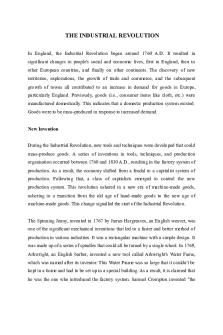Discussion Week 5 - Question 1. How did the Industrial Revolution transform people\'s daily lives? PDF

| Title | Discussion Week 5 - Question 1. How did the Industrial Revolution transform people\'s daily lives? |
|---|---|
| Author | Chris Marshall |
| Course | Technological Transformations |
| Institution | University of Maryland Global Campus |
| Pages | 2 |
| File Size | 59.6 KB |
| File Type | |
| Total Downloads | 27 |
| Total Views | 127 |
Summary
Question 1. How did the Industrial Revolution transform people's daily lives? Be sure to include sanitation and labor....
Description
1. How did the Industrial Revolution transform people's daily lives? Be sure to include sanitation and labor.
The Industrial Revolution was a very important time in history, and had one of the largest and greatest impacts on business and society. Before the revolution, many people worked as farmers or sellers of artisan goods. However, once modern society began the shift to industrialization, machines were started to be used for agriculture and people had to move out of rural areas and into large towns or cities for work (Wilkinson, 2020). Men would move away from families to work in families and unmarried women would work as home servants, as well as textile mills. Children also worked in factories during this time, as their fingers were small enough to weave thread and were paid next to nothing for their dangerous work (White, n.d.). Because of this industrialization, sanitation was an issue. Sewers were subpar, misshapen, and made of horrible materials, leaving sewage draining into the streets. Back alleys and walkways were full of garbage, and the air and water were polluted by the ever-growing factories (Taylor, 2011). Because of this, the death rate was growing higher, and diseases and deformities ran wild. There was a gap on knowledge (ignorance) during this time as well, as scientists just didn’t know what caused this widespread sickness. It wasn’t until 1835, when two doctors wrote essays on living conditions, and a connection was made between sanitation and disease. In 1848, when cholera returned to Britain, a public health act was created to reform sewers and be the authorities on building code, garbage, and water pollution. Finally, in 1875, another public health act gave authorities the power the make decisions on waste disposal, water treatment, and similar environments which created health strategy that led to death rates falling (Wilde, 2019). Factories were not the only dangerous job during this time, working in the mines had people working 14 hours a day for 6 days a week, receiving little pay. Because the bosses of these jobs controlled the pay and lives of the workers, many workers were fearful to complain about horrid conditions and low pay, as they could lose their jobs. But this changed in the 1800s when people started demanding reform. Workers joined union groups, went on strike and used new tactics to “bargain” with companies for better pay, better conditions and a better life. During the time of the revolution, besides the work, things were pretty good for society. Education was higher, goods were produced faster, and people generally had more money than before. The smallpox vaccine and discovery of bacteria was also discovered, meaning an increase in healthcare as well as life expectancy. Nearing the end of the revolution, women had a huge turn in history as they started becoming more political and lobbying for the right to vote. They were finally granted their suffrage in 1920 with the 19th amendment (FCPS, 2014).
References: FCPS. (2014). Social effects of the industrial revolution. Retrieved from https://www.lcps.org/cms/lib4/VA01000195/Centricity/Domain/10599/Social%20Effects%20of %20the%20Industrial%20Revolution.pdf Taylor, L. (2011, June 27). Dirt, waste and revulsion: How cultures cope with leftovers and mess. Retrieved from https://www.open.edu/openlearn/body-mind/dirt-waste-and-revulsion-how-culturescope-leftovers-and-mess
White, M. (n.d.). The industrial revolution. Retrieved from https://learn.umgc.edu/d2l/le/content/544044/viewContent/20910182/View Wilde, R. (2019, August 31). Public health during the industrial revolution. Retrieved from https://www.thoughtco.com/public-health-in-the-industrial-revolution-1221641 Wilkinson, F. (2020, January 27). Industrialization, labor and life. Retrieved from https://www.nationalgeographic.org/article/industrialization-labor-and-life/6th-grade/...
Similar Free PDFs

THE Industrial Revolution
- 4 Pages

The third industrial revolution
- 2 Pages

Industrial Revolution
- 2 Pages

Week 7 Discussion Question
- 2 Pages

Industrial Revolution
- 19 Pages

DQ 1 Week 5 - Discussion
- 1 Pages

Week 5 Discussion 1 - NA
- 1 Pages

Industrial Revolution in Canada
- 5 Pages
Popular Institutions
- Tinajero National High School - Annex
- Politeknik Caltex Riau
- Yokohama City University
- SGT University
- University of Al-Qadisiyah
- Divine Word College of Vigan
- Techniek College Rotterdam
- Universidade de Santiago
- Universiti Teknologi MARA Cawangan Johor Kampus Pasir Gudang
- Poltekkes Kemenkes Yogyakarta
- Baguio City National High School
- Colegio san marcos
- preparatoria uno
- Centro de Bachillerato Tecnológico Industrial y de Servicios No. 107
- Dalian Maritime University
- Quang Trung Secondary School
- Colegio Tecnológico en Informática
- Corporación Regional de Educación Superior
- Grupo CEDVA
- Dar Al Uloom University
- Centro de Estudios Preuniversitarios de la Universidad Nacional de Ingeniería
- 上智大学
- Aakash International School, Nuna Majara
- San Felipe Neri Catholic School
- Kang Chiao International School - New Taipei City
- Misamis Occidental National High School
- Institución Educativa Escuela Normal Juan Ladrilleros
- Kolehiyo ng Pantukan
- Batanes State College
- Instituto Continental
- Sekolah Menengah Kejuruan Kesehatan Kaltara (Tarakan)
- Colegio de La Inmaculada Concepcion - Cebu







